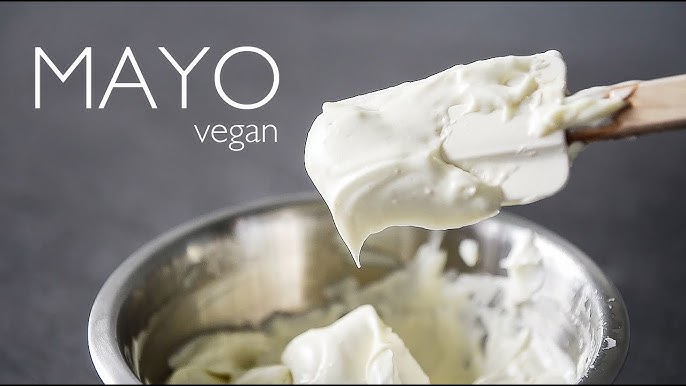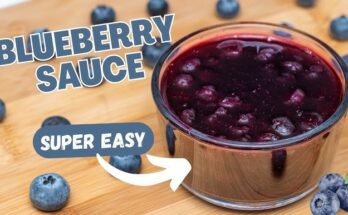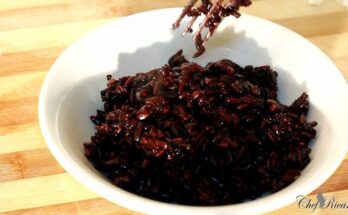Vegan Mayo Recipe: Vegan mayo is a game-changer for plant-based eaters and health-conscious folks alike. It offers that creamy, tangy, and smooth texture we all love—without a single egg. Whether you’re vegan, allergic to eggs, or just trying to make smarter food choices, vegan mayo is an easy and delicious swap for traditional mayonnaise.
Unlike regular mayo, which relies on eggs as an emulsifier, vegan mayo gets its magic from plant-based ingredients like soy milk or aquafaba (chickpea water). The taste? Just as rich, with endless room for flavor customization. Think of it as a blank canvas you can tweak with herbs, garlic, mustard, or a little sriracha for some kick.
Plus, it’s super quick to whip up at home—literally five minutes or less. So if you’re tired of overpriced store-bought options or long ingredient lists with additives you can’t pronounce, this is your chance to take control of what goes into your spread.
Health Benefits of Vegan Mayo
Switching to vegan mayo isn’t just a trend—it’s a smart health move. For starters, it’s cholesterol-free. That’s a huge win for your heart, especially if you’re trying to lower your LDL (the bad cholesterol). Since it uses plant-based oils and non-dairy emulsifiers, you also avoid the saturated fats and additives often found in traditional mayo.
Vegan mayo can be allergy-friendly too. Many people can’t tolerate eggs or dairy, and vegan mayo is naturally free of both. This makes it a perfect option for households with diverse dietary needs—vegan, vegetarian, lactose-intolerant, or allergic to eggs.
Another plus? You can control what goes in. Want something gluten-free? Done. Need it oil-free for an even lighter option? That’s possible too with some simple tweaks. Unlike commercial versions loaded with preservatives, homemade vegan mayo keeps things fresh and clean.
In essence, it’s a healthier, more versatile, and inclusive alternative to regular mayo—without sacrificing flavor or texture.
Essential Ingredients for Vegan Mayo
Creating your own vegan mayo is surprisingly simple. You’ll only need a few basic ingredients, most of which you probably already have in your kitchen:
- Unsweetened Soy Milk or Aquafaba: This acts as the emulsifying agent. Soy milk is the most common because of its protein content, which helps thicken the mayo. Aquafaba (the liquid from canned chickpeas) is another great option and works well in oil-free recipes too.
- Neutral Oil (like Canola, Grapeseed, or Sunflower): This is what gives mayo its creamy texture. Avoid strong-tasting oils like extra virgin olive oil, which can overpower the flavor.
- Apple Cider Vinegar or Lemon Juice: This adds the necessary tang and helps stabilize the mixture.
- Salt: A pinch goes a long way to balance flavors.
- Mustard or Dijon (Optional): Adds depth and a subtle kick.
- Maple Syrup or Agave (Optional): A tiny touch of sweetness rounds out the tang.
If you’re feeling adventurous, you can also toss in garlic powder, smoked paprika, black pepper, or herbs like dill or basil to create unique flavor profiles.
Kitchen Tools You’ll Need
Before you dive into mayo-making, gather your tools. The good news? You don’t need anything fancy:
- Immersion Blender (Hand Blender): This is the best tool for making vegan mayo. It’s fast, easy to clean, and emulsifies perfectly.
- Regular Blender or Food Processor: If you don’t have an immersion blender, a countertop blender works too. Just make sure to blend slowly and monitor the consistency.
- Measuring Cups and Spoons: Precision matters, especially for the oil-to-liquid ratio.
- Tall Jar or Container: This should be just wide enough to fit your immersion blender. A mason jar or tall measuring jug works well.
While a whisk and elbow grease can work in a pinch, using an electric tool gives better and more reliable results. No one wants a runny or split mayo!
Step-by-Step Vegan Mayo Recipe Guide
Let’s get to the fun part—the actual making of the mayo. It’s easier than you think and takes just a few minutes from start to finish.
Step 1 – Gather All Ingredients
First, measure out everything so you’re ready to go:
- 1/2 cup unsweetened soy milk or aquafaba
- 1 cup neutral oil
- 1 tablespoon apple cider vinegar or lemon juice
- 1 teaspoon mustard (optional)
- 1/2 teaspoon salt
- 1/2 teaspoon maple syrup (optional)
Make sure your ingredients are at room temperature—this helps them emulsify better.
Step 2 – Choose Your Blending Method
Place all the ingredients in a tall container. If you’re using an immersion blender, it should just fit in the bottom. If you’re using a regular blender, add the liquids first and slowly drizzle in the oil as it blends.
Ready?
Step 3 – Start Emulsifying
Now for the magic moment—emulsifying! If you’re using an immersion blender, place it at the very bottom of the jar, ensuring it’s resting flat. Turn it on and blend without moving it for about 10-15 seconds. You’ll start to see the bottom layers transform into a thick, creamy mayo.
Once the bottom has emulsified, slowly tilt and lift the blender to incorporate the rest of the oil and ingredients. In about 30–45 seconds, you should have a smooth, fluffy mayo. It’s truly satisfying to watch the ingredients turn into that luscious texture right before your eyes.
Using a regular blender? Start on low speed and pour the oil in very slowly while it’s blending. This gradual mix is crucial—it’s what allows the oil and liquid to emulsify rather than separate. Once it thickens up, you can increase the speed for a few seconds to finish the blend.
Tip: If your mayo looks too runny, try adding a little more oil while blending. If it’s too thick, a splash of plant milk can loosen it up.
Step 4 – Adjust Texture and Flavor
Taste testing time! Your vegan mayo should now be thick, creamy, and delicious—but don’t be afraid to tweak it:
- Want it tangier? Add another dash of vinegar or lemon juice.
- Craving a kick? Stir in some garlic, sriracha, or black pepper.
- Need it a bit sweeter? A touch more maple syrup does the trick.
- Prefer it extra smooth? Blend again for 5–10 seconds.
The beauty of making your own mayo is that you can totally make it yours. This is your moment to personalize it—just don’t overblend, or the oil may start to separate and turn the mixture greasy.
Texture-wise, it should stick to a spoon without sliding off too easily, like thick yogurt. It will firm up a little more after chilling in the fridge.
Step 5 – Store It Right
Storage is key to maintaining that fresh flavor and perfect consistency. Once you’re satisfied with the taste and texture, scoop your vegan mayo into a clean, airtight container or glass jar with a lid.
Pop it in the fridge, where it will continue to thicken slightly. Homemade vegan mayo typically lasts about 7–10 days when refrigerated properly. Always use a clean spoon when scooping to avoid introducing bacteria.
Keep an eye on any changes in smell or texture. If it turns watery, curdles, or smells funky, it’s time to toss it and make a new batch.
Here’s a quick tip: Label the container with the date you made it. This helps track freshness and ensures you’re always using it at its best.
Tips for Perfect Vegan Mayo Every Time
Perfecting vegan mayo is part science, part art. Here are some pro tips to ensure you nail it every single time:
- Use Room-Temperature Ingredients: Cold soy milk or oil can cause separation and prevent emulsification.
- Stick to Unsweetened Plant Milk: Sweetened or flavored varieties will ruin the taste. Soy milk works best due to its high protein content, but you can experiment with oat, almond, or aquafaba.
- Choose a Neutral Oil: Oils like canola, sunflower, or grapeseed are ideal. Avoid olive oil or coconut oil for this recipe—they’re too strong in flavor or solidify when chilled.
- Add Acid for Stability: Vinegar or lemon juice isn’t just for flavor—it helps stabilize the mayo and extends its shelf life.
- Slow and Steady Blending: Don’t rush the blending process, especially if using a regular blender. Pour the oil in slowly to let emulsification happen properly.
Common Mistakes to Avoid:
- Using sweetened plant milk – It’ll throw off the whole flavor.
- Skipping the acid – No vinegar or lemon = flat taste and poor texture.
- Over-blending – It can break the emulsion, leading to a runny or oily mess.
- Using hot or very cold ingredients – This can also prevent the mayo from thickening properly.
Follow these guidelines, and your vegan mayo will be spot-on every time.
Flavor Variations to Try
Once you’ve mastered the basic vegan mayo recipe, it’s time to have some fun with it. One of the best things about homemade vegan mayo is how easy it is to tweak. With just a few additions, you can create gourmet versions that rival any specialty condiment you’d find in stores.
Garlic Mayo (Aioli)
Craving a bold, savory twist? Add 1–2 minced garlic cloves or 1 teaspoon of garlic powder to your base recipe. Blend it again for that perfect garlicky kick. This variation is perfect as a dip for fries, a spread for sandwiches, or even drizzled over roasted veggies.
Spicy Sriracha Mayo
If you like things hot, this one’s for you. Mix in 1–2 tablespoons of sriracha (or your favorite hot sauce) into the mayo. You can even add a pinch of smoked paprika for extra depth. It pairs incredibly well with veggie burgers, wraps, and even sushi rolls.
Herb-Infused Mayo
Go green by blending in fresh herbs like basil, dill, parsley, or cilantro. Not only does this add a burst of flavor, but it also gives your mayo a beautiful green tint. This version works well in potato salads or as a dip for crudité platters.
Chipotle Mayo
Smoky and spicy, chipotle mayo is a fan favorite. Just add 1–2 teaspoons of canned chipotle in adobo sauce and a splash of lime juice to your base. This one’s amazing on tacos, black bean burgers, or sweet potato fries.
You can also play around with ingredients like curry powder, horseradish, Dijon mustard, or nutritional yeast. Just start small and taste as you go.
How to Use Vegan Mayo
Vegan mayo is much more than just a sandwich spread. Once you start using it, you’ll find it sneaking its way into all kinds of dishes.
As a Spread
Use it on toast, wraps, bagels, burgers, and sandwiches. It adds that creamy, tangy flavor we all crave—and keeps your bread from drying out.
In Salads
Potato salad, pasta salad, coleslaw—you name it. Vegan mayo acts as a great binder and adds a creamy base to salads. You can also mix it with mustard or vinegar to lighten it up.
As a Dip
Mix it with a bit of ketchup or hot sauce for a quick and easy dip. Add herbs and garlic for a more gourmet feel. Great for fries, onion rings, or veggie sticks.
Sauce Base
Vegan mayo is a fantastic base for sauces and dressings. Blend it with balsamic vinegar, soy sauce, tahini, or your favorite seasoning to create a custom sauce for bowls, grain salads, or roasted veggies.
In Baking
Believe it or not, vegan mayo can even be used in baking. It acts as a moisture-retaining agent in some cakes or muffins. Just replace eggs or oil with mayo in certain recipes for a richer texture.
Once you realize how versatile it is, you’ll start seeing vegan mayo as a kitchen essential rather than just a condiment.
Storing and Shelf Life
Proper storage of homemade vegan mayo is essential to ensure safety and maintain its taste and texture. Here’s what you need to know:
Refrigeration
Always store your vegan mayo in an airtight container or jar with a tight lid. Mason jars work beautifully. It should be kept in the fridge at all times and used within 7–10 days. Some versions may last up to two weeks, but it’s best to err on the side of caution.
Label It
Mark the jar with the date you made it so you can keep track of freshness. If you’re experimenting with flavors, label those too—it’ll save confusion later on.
Signs It’s Gone Bad
- Smell: If it has a sour or funky odor, toss it.
- Texture: If the mayo becomes watery or separated, it’s no longer good.
- Color: Any discoloration (especially yellowing or greying) is a sign to discard.
If you notice any mold, even around the rim of the jar, discard the entire batch immediately.
Remember, homemade vegan mayo doesn’t contain the preservatives found in store-bought versions. Treat it like any fresh food and always use clean utensils when scooping to prevent contamination.
Vegan Mayo vs Regular Mayo – A Quick Comparison
Still wondering how vegan mayo stacks up against traditional mayo? Let’s break it down:
| Feature | Vegan Mayo | Regular Mayo |
|---|---|---|
| Base Ingredients | Plant milk, oil, vinegar, seasoning | Eggs, oil, vinegar, seasoning |
| Cholesterol | 0 mg | High (due to egg yolks) |
| Saturated Fat | Lower (depending on oil used) | Higher (especially if made with eggs) |
| Flavor | Creamy, slightly tangy | Creamy, eggy, slightly tangy |
| Texture | Thick and smooth | Thick and smooth |
| Allergens | Egg-free, often soy-free or nut-free | Contains eggs, may cause allergies |
| Diet-Friendly | Vegan, vegetarian, plant-based | Not suitable for vegan or egg-free diets |
As you can see, vegan mayo offers a more inclusive and heart-friendly option without compromising on taste or texture.
Common Mistakes to Avoid
Even though vegan mayo is super simple to make, there are a few traps that can trip you up—especially the first time. Here are the most common mistakes people make and how to dodge them like a pro.
1. Using the Wrong Kind of Plant Milk
Not all plant-based milks are created equal. For mayo, you need something rich in protein to help the emulsification process. Unsweetened soy milk is your best bet. Almond milk and oat milk can work, but they tend to be a bit finicky and less reliable. Avoid sweetened, flavored, or vanilla varieties—they’ll ruin the taste.
2. Adding Cold Ingredients
Temperature matters! Cold soy milk or oil can cause the emulsion to fail. Always let your ingredients sit at room temperature for 10–15 minutes before blending. This gives them the best chance to mix properly and avoid separation.
3. Skipping the Acid
Vinegar or lemon juice isn’t optional. It’s critical for both flavor and texture. Without acid, your mayo may taste flat or even bitter. It also helps with stability and preservation, so don’t leave it out.
4. Using Strong-Tasting Oils
Avoid oils like extra virgin olive oil, sesame, or coconut oil. These will overpower the flavor and give you a mayo that tastes… off. Stick with neutral oils like canola, grapeseed, sunflower, or light olive oil (not extra virgin).
5. Over-Blending or Under-Blending
Blending for too long can break the emulsion and turn your mayo into a runny mess. On the flip side, under-blending won’t fully thicken the mixture. Find that sweet spot—typically 30 to 45 seconds of blending time is all you need.
6. Not Tasting as You Go
Don’t just follow the recipe to the letter—taste your mayo! Adjust salt, acid, or sweetness to your preference. Remember, your taste buds are the best tool in your kitchen.
By steering clear of these pitfalls, you’ll ensure that every batch of vegan mayo turns out creamy, flavorful, and just the way you like it.
FAQs about Vegan Mayo Recipe
Can I use olive oil instead of canola or sunflower oil?
Technically yes, but only light-tasting olive oil. Extra virgin olive oil is too strong and can make your mayo taste bitter. Stick with neutral oils for best results.
How long does homemade vegan mayo last?
About 7 to 10 days in the refrigerator, stored in an airtight container. Always use clean utensils and discard it if you notice any changes in smell or texture.
Can I make it without a blender?
It’s possible but challenging. Whisking by hand is labor-intensive and doesn’t guarantee the same smooth, thick texture. An immersion blender or food processor is highly recommended.
Is it safe for kids?
Absolutely! Vegan mayo is egg-free and made with simple, clean ingredients. Just be mindful of any food allergies like soy or mustard.
Can I freeze vegan mayo?
It’s not recommended. Freezing will change the texture and make it watery when thawed. Always make small batches you can use up within a week or so.
Conclusion
Vegan mayo is a total game-changer—easy to make, endlessly customizable, and a healthier, allergy-friendly alternative to traditional mayonnaise. Whether you’re spreading it on sandwiches, tossing it into salads, or stirring it into sauces, it’s a must-have for any kitchen, plant-based or not.
The beauty lies in its simplicity. With just a few ingredients and a blender, you can whip up a fresh, preservative-free condiment that’s better than store-bought in every way. And once you’ve nailed the basic version, the possibilities are endless—from spicy to herby, tangy to sweet.
So next time you run out of mayo, skip the store run. Head to your kitchen, grab that blender, and make a batch that’s tastier, healthier, and totally yours.



